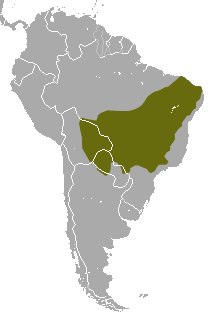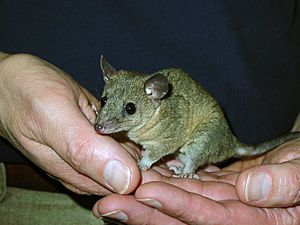Gray short-tailed opossum facts for kids
Quick facts for kids Gray short-tailed opossum |
|
|---|---|
 |
|
| Conservation status | |
| Scientific classification | |
| Genus: |
Monodelphis
|
| Species: |
domestica
|
 |
|
| Gray short-tailed opossum range | |
| Synonyms | |
|
Monodelphis domesticus |
|
The gray short-tailed opossum (Monodelphis domestica) is a small animal from South America. It belongs to the family called Didelphidae. Unlike most other marsupials, this opossum does not have a true pouch to carry its young.
Its scientific name, Monodelphis, comes from Greek words meaning "single womb." This refers to the fact that it doesn't have a pouch. The word domestica comes from Latin and means "domestic," because these opossums often enter human homes.
This amazing creature was the first marsupial to have its entire genome sequenced. This means scientists mapped out all its DNA. The gray short-tailed opossum is used as a research model in science. It is also a popular exotic pet. People sometimes call it the Brazilian opossum, rainforest opossum, or laboratory opossum when it's used for research.
Contents
What They Look Like
Gray short-tailed opossums are quite small animals. They look a bit like voles. In the wild, their bodies are about 12 to 18 centimeters (5 to 7 inches) long. They weigh between 58 and 95 grams (2 to 3.4 ounces). Male opossums are usually bigger than females.
However, opossums kept in zoos or labs can be much larger. Males might weigh up to 150 grams (5.3 ounces). Their tails are shorter than those of some other opossums, measuring about 5 to 9 centimeters (2 to 3.5 inches). Their tails can grab things a little bit, but not as well as the tails of opossums like the North American opossum.
Their fur is mostly grayish-brown. It gets lighter on their bellies and is almost white on their feet. Only the base of their tail has fur; the rest is mostly hairless. They have strong, curved claws. Their paws have small pads with tiny ridges, like fingerprints. As mentioned, female gray short-tailed opossums do not have a pouch. They usually have thirteen teats, which can pull back into their bodies.
Where They Live
The gray short-tailed opossum lives mostly south of the Amazon River. You can find them in southern, central, and western Brazil. They also live in eastern Bolivia, northern Paraguay, and in Formosa Province in northern Argentina.
These opossums live in rainforests, scrubland, and even on farms. They often go into buildings made by humans, like houses. There are no different types or subspecies of this opossum.
How They Behave
Gray short-tailed opossums eat rodents, frogs, reptiles, and invertebrates (like insects). They also eat some fruits. They mostly hunt using their sense of smell. They poke their snouts into plants to find prey or dead animals to eat.
When they find living prey, they pounce on it. They hold it down with their front paws and deliver a quick, deadly bite, often to the neck. They can even catch prey that is as big as they are!
These opossums are nocturnal, meaning they are active at night. They are busiest in the first three hours after sunset. Sometimes they hide in natural rock cracks. But usually, they spend the day in hidden nests made of leaves, bark, and other materials. Female opossums build more complex and tightly woven nests than males.
They are solitary animals, meaning they live alone. They only come together to mate. Each opossum has its own area, about 1,200 to 1,800 square meters (13,000 to 19,000 square feet). They mark their areas with scent marks. If another opossum comes too close, they often hiss and screech. This can turn into defensive attacks where they stand on their back legs.
Reproduction and Life Cycle
Gray short-tailed opossums can breed all year long if the weather is good. A female can have up to six litters in a good year, with six to eleven young in each litter. Females only become ready to mate when they smell male pheromones. They only release eggs when they have physical contact with a male.
Pregnancy lasts about fourteen days. After birth, the tiny young attach to a teat and stay there for two weeks. Like all marsupials, the babies are born very undeveloped. At birth, they are only about 1 centimeter (0.4 inches) long and weigh just 0.1 gram (0.0035 ounces).
The young opossums start growing fur at around three weeks old. They open their eyes about a week later. They stop drinking milk from their mother at eight weeks old. Gray short-tailed opossums can have their own babies when they are five to six months old. In captivity, they can live for up to forty-nine months (about four years).
Laboratory Opossum
The gray short-tailed opossum has several features that make it a great research model. This means scientists use it to study how living things work. It's especially useful for studying marsupials. It also helps scientists learn about the immune system and how mammals develop.
These opossums breed quite easily in labs. Their babies are born very undeveloped and can be easily seen and studied. This is because female opossums don't have a pouch. The babies just cling to the teats.
Opossum babies are born at a stage similar to a 13- to 15-day-old fetal rat or a 40-day-old human embryo. Like other marsupials, their young immune systems are not fully developed. This makes them perfect for studying transplants and cancer research. They also help scientists understand how the immune system develops in general and how it is similar to other mammals.
Their entire genome (all their DNA) was mapped out in May 2007. This work, led by MIT and Harvard, showed that the opossum has between 18,000 and 20,000 protein-coding genes. You can find the full genome sequence and details on the Ensembl Genome Browser.
See also
 In Spanish: Colicorto gris para niños
In Spanish: Colicorto gris para niños



